Strategic Management and Leadership: Skills and Knowledge Report
VerifiedAdded on 2023/01/13
|22
|4767
|88
Report
AI Summary
This report delves into the core concepts of strategic management and leadership, examining the role of a personal development plan (PDP) in aligning individual growth with organizational objectives. It begins by constructing a PDP for a strategic manager, outlining short, medium, and long-term goals, and then evaluates the impact of such a plan on both personal and organizational development, emphasizing how PDPs can be measured through various metrics like employee retention and goal achievement. The report further analyzes how the development plan affects, or could affect, the achievement of organizational objectives. The report then transitions to decision-making processes, identifying the types of data available to a strategic manager, including descriptive, diagnostic, predictive, and prescriptive data. It includes a detailed analysis of core financial data, specifically comparative income statements, drawing conclusions about the financial performance of a company. Finally, the report discusses methods for recommending courses of action and organizational improvements based on these conclusions, including effective presentation methods. The report provides valuable insights into the practical application of strategic management and leadership principles within an organizational context.

Running head: STRATEGIC MANAGEMENT AND LEADERSHIP
1
Strategic management and leadership
Name:
Institution:
1
Strategic management and leadership
Name:
Institution:
Paraphrase This Document
Need a fresh take? Get an instant paraphrase of this document with our AI Paraphraser
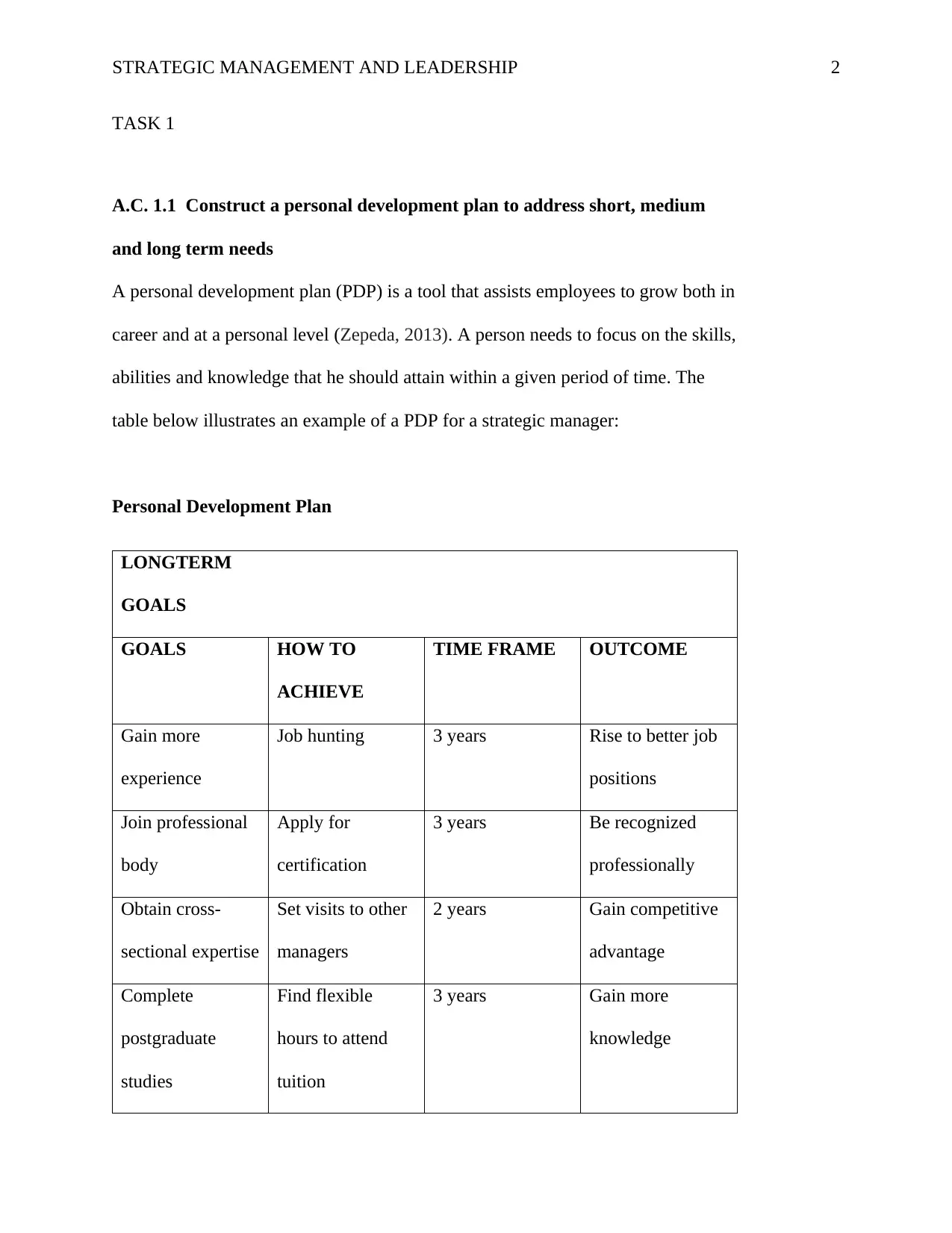
STRATEGIC MANAGEMENT AND LEADERSHIP 2
TASK 1
A.C. 1.1 Construct a personal development plan to address short, medium
and long term needs
A personal development plan (PDP) is a tool that assists employees to grow both in
career and at a personal level (Zepeda, 2013). A person needs to focus on the skills,
abilities and knowledge that he should attain within a given period of time. The
table below illustrates an example of a PDP for a strategic manager:
Personal Development Plan
LONGTERM
GOALS
GOALS HOW TO
ACHIEVE
TIME FRAME OUTCOME
Gain more
experience
Job hunting 3 years Rise to better job
positions
Join professional
body
Apply for
certification
3 years Be recognized
professionally
Obtain cross-
sectional expertise
Set visits to other
managers
2 years Gain competitive
advantage
Complete
postgraduate
studies
Find flexible
hours to attend
tuition
3 years Gain more
knowledge
TASK 1
A.C. 1.1 Construct a personal development plan to address short, medium
and long term needs
A personal development plan (PDP) is a tool that assists employees to grow both in
career and at a personal level (Zepeda, 2013). A person needs to focus on the skills,
abilities and knowledge that he should attain within a given period of time. The
table below illustrates an example of a PDP for a strategic manager:
Personal Development Plan
LONGTERM
GOALS
GOALS HOW TO
ACHIEVE
TIME FRAME OUTCOME
Gain more
experience
Job hunting 3 years Rise to better job
positions
Join professional
body
Apply for
certification
3 years Be recognized
professionally
Obtain cross-
sectional expertise
Set visits to other
managers
2 years Gain competitive
advantage
Complete
postgraduate
studies
Find flexible
hours to attend
tuition
3 years Gain more
knowledge
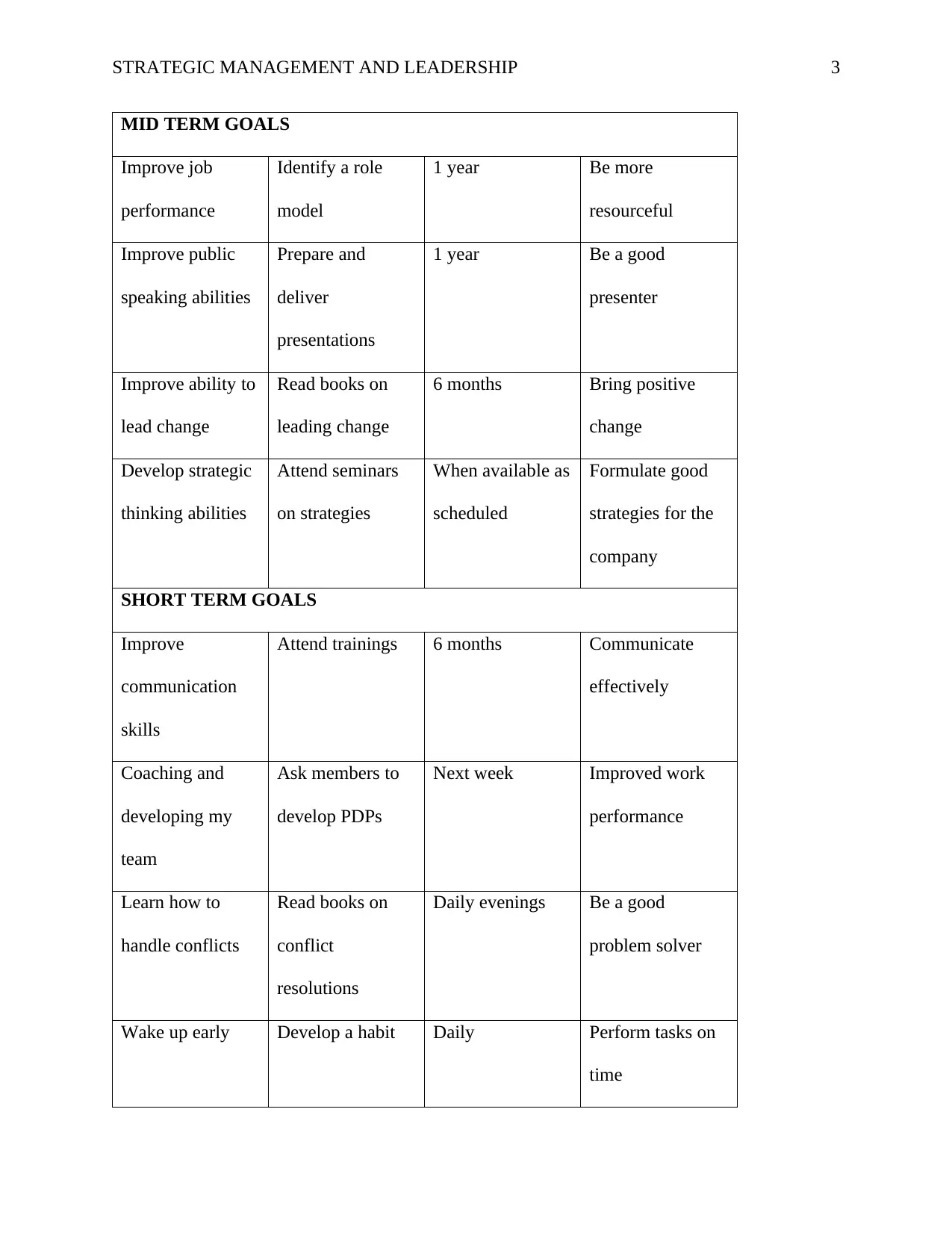
STRATEGIC MANAGEMENT AND LEADERSHIP 3
MID TERM GOALS
Improve job
performance
Identify a role
model
1 year Be more
resourceful
Improve public
speaking abilities
Prepare and
deliver
presentations
1 year Be a good
presenter
Improve ability to
lead change
Read books on
leading change
6 months Bring positive
change
Develop strategic
thinking abilities
Attend seminars
on strategies
When available as
scheduled
Formulate good
strategies for the
company
SHORT TERM GOALS
Improve
communication
skills
Attend trainings 6 months Communicate
effectively
Coaching and
developing my
team
Ask members to
develop PDPs
Next week Improved work
performance
Learn how to
handle conflicts
Read books on
conflict
resolutions
Daily evenings Be a good
problem solver
Wake up early Develop a habit Daily Perform tasks on
time
MID TERM GOALS
Improve job
performance
Identify a role
model
1 year Be more
resourceful
Improve public
speaking abilities
Prepare and
deliver
presentations
1 year Be a good
presenter
Improve ability to
lead change
Read books on
leading change
6 months Bring positive
change
Develop strategic
thinking abilities
Attend seminars
on strategies
When available as
scheduled
Formulate good
strategies for the
company
SHORT TERM GOALS
Improve
communication
skills
Attend trainings 6 months Communicate
effectively
Coaching and
developing my
team
Ask members to
develop PDPs
Next week Improved work
performance
Learn how to
handle conflicts
Read books on
conflict
resolutions
Daily evenings Be a good
problem solver
Wake up early Develop a habit Daily Perform tasks on
time
⊘ This is a preview!⊘
Do you want full access?
Subscribe today to unlock all pages.

Trusted by 1+ million students worldwide
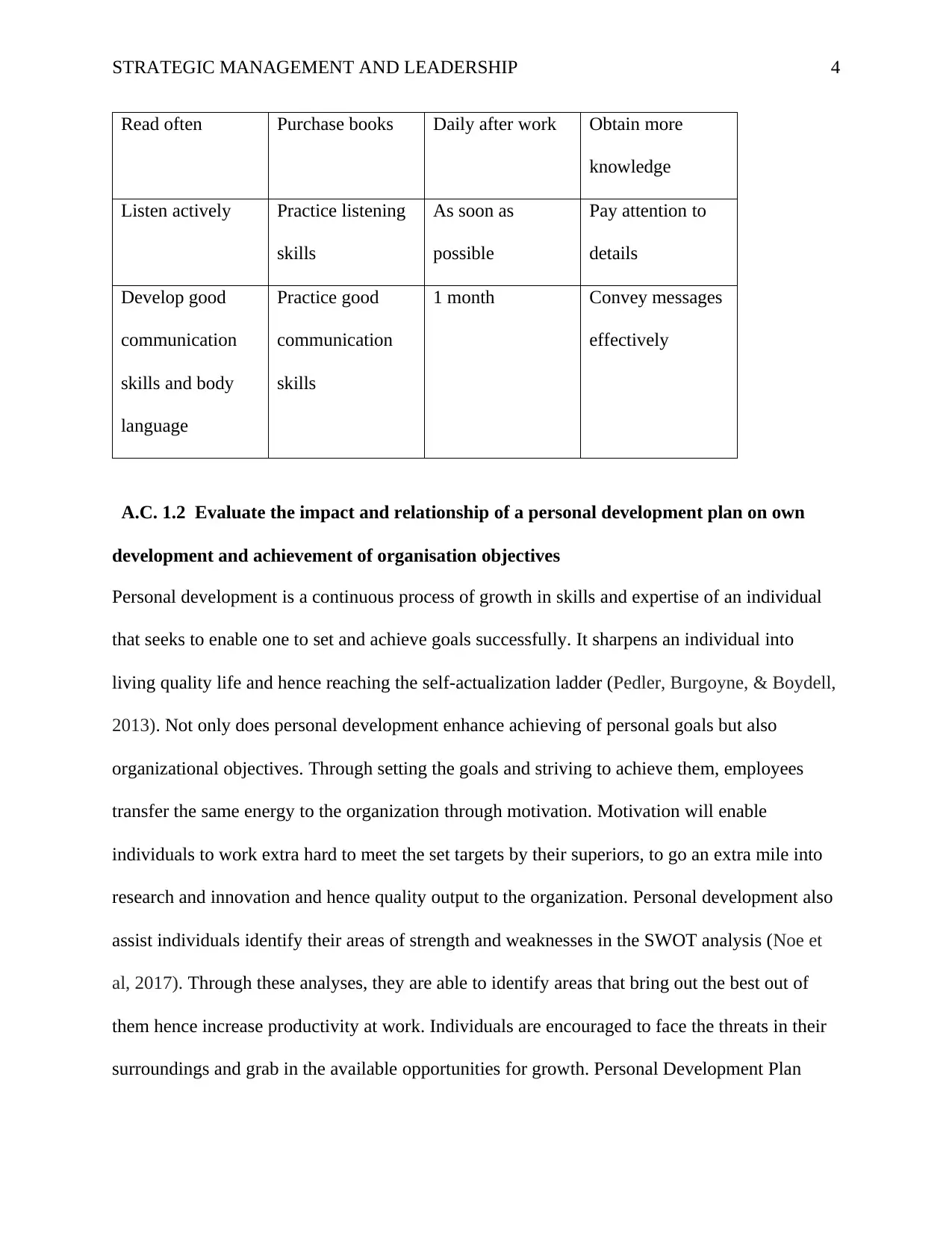
STRATEGIC MANAGEMENT AND LEADERSHIP 4
Read often Purchase books Daily after work Obtain more
knowledge
Listen actively Practice listening
skills
As soon as
possible
Pay attention to
details
Develop good
communication
skills and body
language
Practice good
communication
skills
1 month Convey messages
effectively
A.C. 1.2 Evaluate the impact and relationship of a personal development plan on own
development and achievement of organisation objectives
Personal development is a continuous process of growth in skills and expertise of an individual
that seeks to enable one to set and achieve goals successfully. It sharpens an individual into
living quality life and hence reaching the self-actualization ladder (Pedler, Burgoyne, & Boydell,
2013). Not only does personal development enhance achieving of personal goals but also
organizational objectives. Through setting the goals and striving to achieve them, employees
transfer the same energy to the organization through motivation. Motivation will enable
individuals to work extra hard to meet the set targets by their superiors, to go an extra mile into
research and innovation and hence quality output to the organization. Personal development also
assist individuals identify their areas of strength and weaknesses in the SWOT analysis (Noe et
al, 2017). Through these analyses, they are able to identify areas that bring out the best out of
them hence increase productivity at work. Individuals are encouraged to face the threats in their
surroundings and grab in the available opportunities for growth. Personal Development Plan
Read often Purchase books Daily after work Obtain more
knowledge
Listen actively Practice listening
skills
As soon as
possible
Pay attention to
details
Develop good
communication
skills and body
language
Practice good
communication
skills
1 month Convey messages
effectively
A.C. 1.2 Evaluate the impact and relationship of a personal development plan on own
development and achievement of organisation objectives
Personal development is a continuous process of growth in skills and expertise of an individual
that seeks to enable one to set and achieve goals successfully. It sharpens an individual into
living quality life and hence reaching the self-actualization ladder (Pedler, Burgoyne, & Boydell,
2013). Not only does personal development enhance achieving of personal goals but also
organizational objectives. Through setting the goals and striving to achieve them, employees
transfer the same energy to the organization through motivation. Motivation will enable
individuals to work extra hard to meet the set targets by their superiors, to go an extra mile into
research and innovation and hence quality output to the organization. Personal development also
assist individuals identify their areas of strength and weaknesses in the SWOT analysis (Noe et
al, 2017). Through these analyses, they are able to identify areas that bring out the best out of
them hence increase productivity at work. Individuals are encouraged to face the threats in their
surroundings and grab in the available opportunities for growth. Personal Development Plan
Paraphrase This Document
Need a fresh take? Get an instant paraphrase of this document with our AI Paraphraser
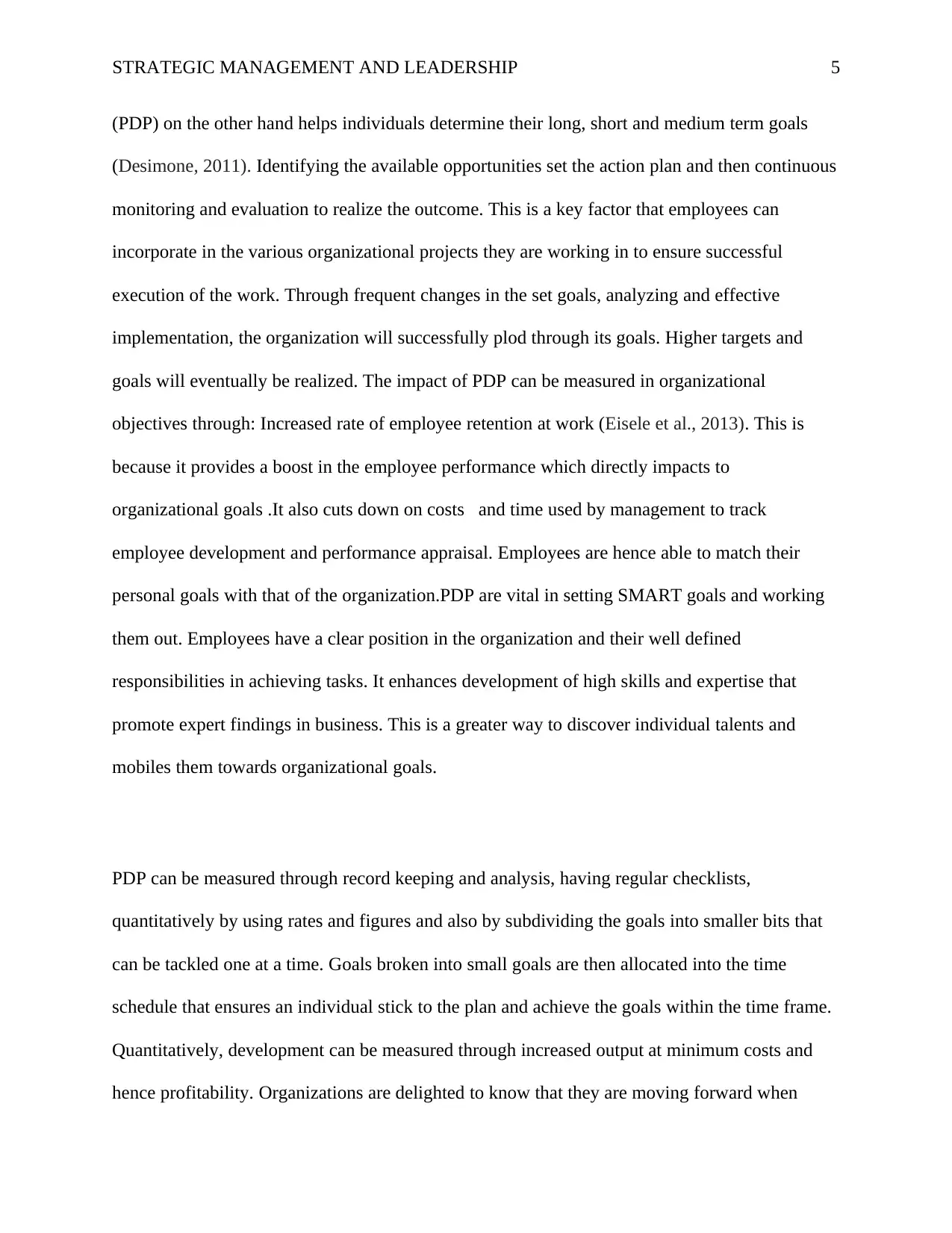
STRATEGIC MANAGEMENT AND LEADERSHIP 5
(PDP) on the other hand helps individuals determine their long, short and medium term goals
(Desimone, 2011). Identifying the available opportunities set the action plan and then continuous
monitoring and evaluation to realize the outcome. This is a key factor that employees can
incorporate in the various organizational projects they are working in to ensure successful
execution of the work. Through frequent changes in the set goals, analyzing and effective
implementation, the organization will successfully plod through its goals. Higher targets and
goals will eventually be realized. The impact of PDP can be measured in organizational
objectives through: Increased rate of employee retention at work (Eisele et al., 2013). This is
because it provides a boost in the employee performance which directly impacts to
organizational goals .It also cuts down on costs and time used by management to track
employee development and performance appraisal. Employees are hence able to match their
personal goals with that of the organization.PDP are vital in setting SMART goals and working
them out. Employees have a clear position in the organization and their well defined
responsibilities in achieving tasks. It enhances development of high skills and expertise that
promote expert findings in business. This is a greater way to discover individual talents and
mobiles them towards organizational goals.
PDP can be measured through record keeping and analysis, having regular checklists,
quantitatively by using rates and figures and also by subdividing the goals into smaller bits that
can be tackled one at a time. Goals broken into small goals are then allocated into the time
schedule that ensures an individual stick to the plan and achieve the goals within the time frame.
Quantitatively, development can be measured through increased output at minimum costs and
hence profitability. Organizations are delighted to know that they are moving forward when
(PDP) on the other hand helps individuals determine their long, short and medium term goals
(Desimone, 2011). Identifying the available opportunities set the action plan and then continuous
monitoring and evaluation to realize the outcome. This is a key factor that employees can
incorporate in the various organizational projects they are working in to ensure successful
execution of the work. Through frequent changes in the set goals, analyzing and effective
implementation, the organization will successfully plod through its goals. Higher targets and
goals will eventually be realized. The impact of PDP can be measured in organizational
objectives through: Increased rate of employee retention at work (Eisele et al., 2013). This is
because it provides a boost in the employee performance which directly impacts to
organizational goals .It also cuts down on costs and time used by management to track
employee development and performance appraisal. Employees are hence able to match their
personal goals with that of the organization.PDP are vital in setting SMART goals and working
them out. Employees have a clear position in the organization and their well defined
responsibilities in achieving tasks. It enhances development of high skills and expertise that
promote expert findings in business. This is a greater way to discover individual talents and
mobiles them towards organizational goals.
PDP can be measured through record keeping and analysis, having regular checklists,
quantitatively by using rates and figures and also by subdividing the goals into smaller bits that
can be tackled one at a time. Goals broken into small goals are then allocated into the time
schedule that ensures an individual stick to the plan and achieve the goals within the time frame.
Quantitatively, development can be measured through increased output at minimum costs and
hence profitability. Organizations are delighted to know that they are moving forward when
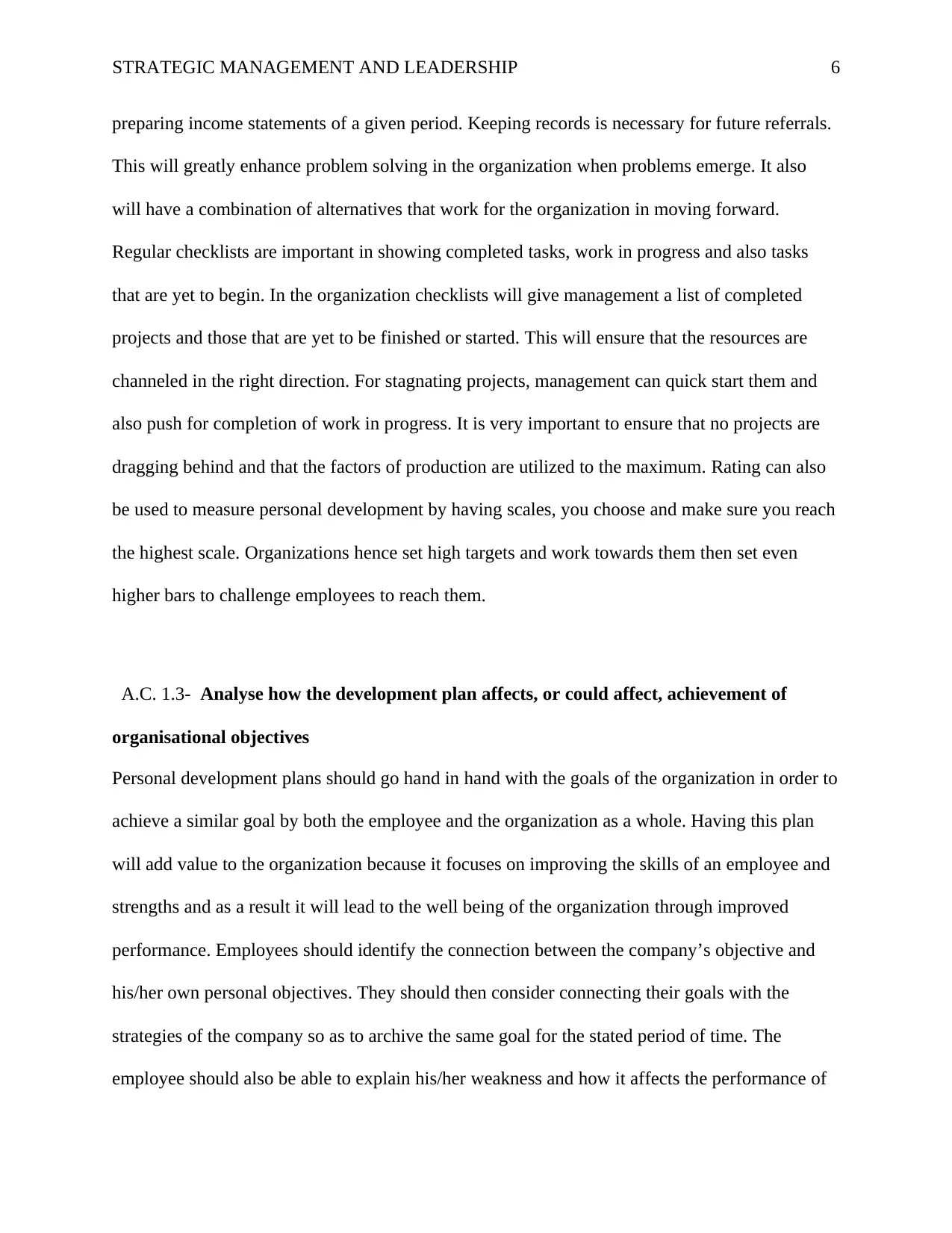
STRATEGIC MANAGEMENT AND LEADERSHIP 6
preparing income statements of a given period. Keeping records is necessary for future referrals.
This will greatly enhance problem solving in the organization when problems emerge. It also
will have a combination of alternatives that work for the organization in moving forward.
Regular checklists are important in showing completed tasks, work in progress and also tasks
that are yet to begin. In the organization checklists will give management a list of completed
projects and those that are yet to be finished or started. This will ensure that the resources are
channeled in the right direction. For stagnating projects, management can quick start them and
also push for completion of work in progress. It is very important to ensure that no projects are
dragging behind and that the factors of production are utilized to the maximum. Rating can also
be used to measure personal development by having scales, you choose and make sure you reach
the highest scale. Organizations hence set high targets and work towards them then set even
higher bars to challenge employees to reach them.
A.C. 1.3- Analyse how the development plan affects, or could affect, achievement of
organisational objectives
Personal development plans should go hand in hand with the goals of the organization in order to
achieve a similar goal by both the employee and the organization as a whole. Having this plan
will add value to the organization because it focuses on improving the skills of an employee and
strengths and as a result it will lead to the well being of the organization through improved
performance. Employees should identify the connection between the company’s objective and
his/her own personal objectives. They should then consider connecting their goals with the
strategies of the company so as to archive the same goal for the stated period of time. The
employee should also be able to explain his/her weakness and how it affects the performance of
preparing income statements of a given period. Keeping records is necessary for future referrals.
This will greatly enhance problem solving in the organization when problems emerge. It also
will have a combination of alternatives that work for the organization in moving forward.
Regular checklists are important in showing completed tasks, work in progress and also tasks
that are yet to begin. In the organization checklists will give management a list of completed
projects and those that are yet to be finished or started. This will ensure that the resources are
channeled in the right direction. For stagnating projects, management can quick start them and
also push for completion of work in progress. It is very important to ensure that no projects are
dragging behind and that the factors of production are utilized to the maximum. Rating can also
be used to measure personal development by having scales, you choose and make sure you reach
the highest scale. Organizations hence set high targets and work towards them then set even
higher bars to challenge employees to reach them.
A.C. 1.3- Analyse how the development plan affects, or could affect, achievement of
organisational objectives
Personal development plans should go hand in hand with the goals of the organization in order to
achieve a similar goal by both the employee and the organization as a whole. Having this plan
will add value to the organization because it focuses on improving the skills of an employee and
strengths and as a result it will lead to the well being of the organization through improved
performance. Employees should identify the connection between the company’s objective and
his/her own personal objectives. They should then consider connecting their goals with the
strategies of the company so as to archive the same goal for the stated period of time. The
employee should also be able to explain his/her weakness and how it affects the performance of
⊘ This is a preview!⊘
Do you want full access?
Subscribe today to unlock all pages.

Trusted by 1+ million students worldwide
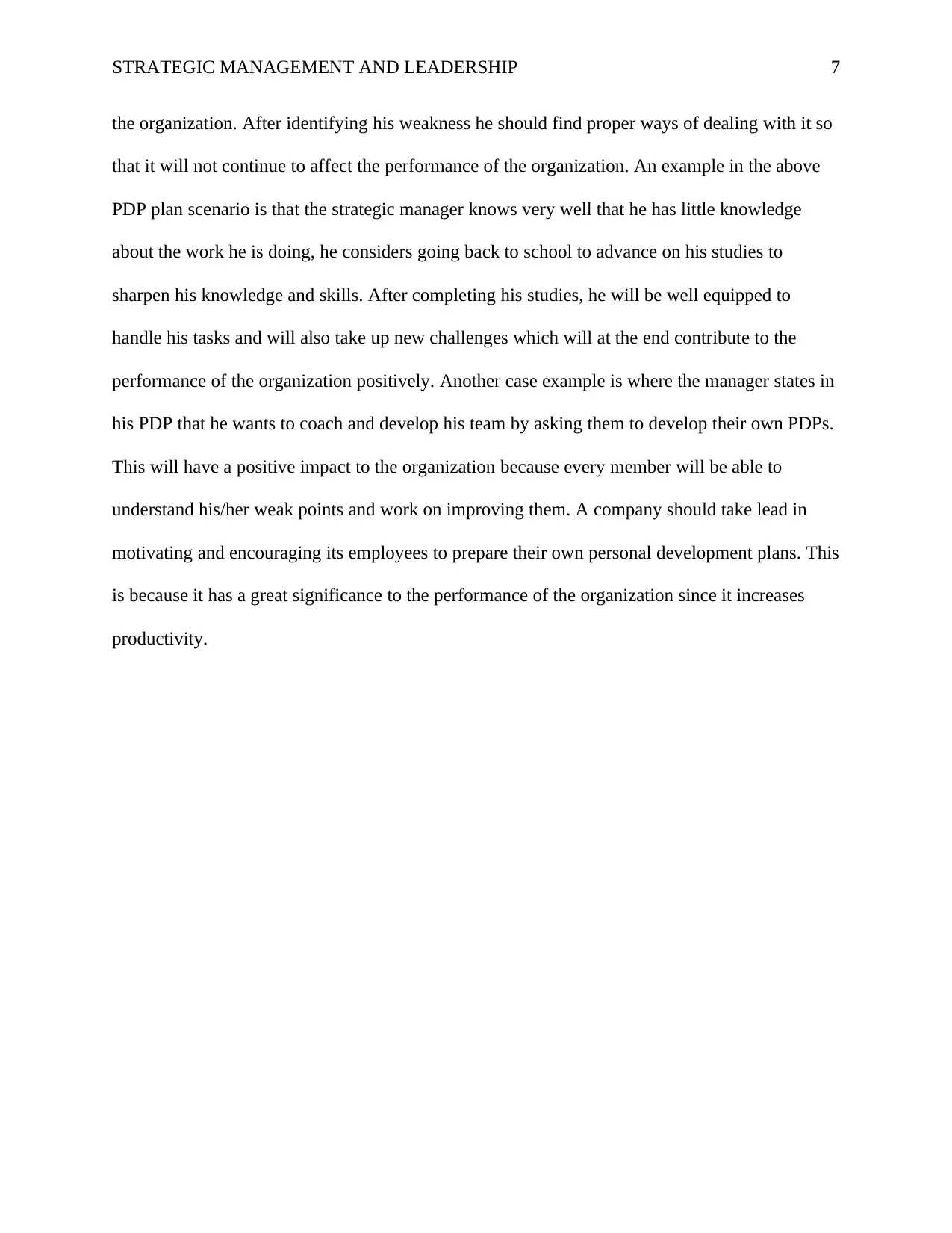
STRATEGIC MANAGEMENT AND LEADERSHIP 7
the organization. After identifying his weakness he should find proper ways of dealing with it so
that it will not continue to affect the performance of the organization. An example in the above
PDP plan scenario is that the strategic manager knows very well that he has little knowledge
about the work he is doing, he considers going back to school to advance on his studies to
sharpen his knowledge and skills. After completing his studies, he will be well equipped to
handle his tasks and will also take up new challenges which will at the end contribute to the
performance of the organization positively. Another case example is where the manager states in
his PDP that he wants to coach and develop his team by asking them to develop their own PDPs.
This will have a positive impact to the organization because every member will be able to
understand his/her weak points and work on improving them. A company should take lead in
motivating and encouraging its employees to prepare their own personal development plans. This
is because it has a great significance to the performance of the organization since it increases
productivity.
the organization. After identifying his weakness he should find proper ways of dealing with it so
that it will not continue to affect the performance of the organization. An example in the above
PDP plan scenario is that the strategic manager knows very well that he has little knowledge
about the work he is doing, he considers going back to school to advance on his studies to
sharpen his knowledge and skills. After completing his studies, he will be well equipped to
handle his tasks and will also take up new challenges which will at the end contribute to the
performance of the organization positively. Another case example is where the manager states in
his PDP that he wants to coach and develop his team by asking them to develop their own PDPs.
This will have a positive impact to the organization because every member will be able to
understand his/her weak points and work on improving them. A company should take lead in
motivating and encouraging its employees to prepare their own personal development plans. This
is because it has a great significance to the performance of the organization since it increases
productivity.
Paraphrase This Document
Need a fresh take? Get an instant paraphrase of this document with our AI Paraphraser
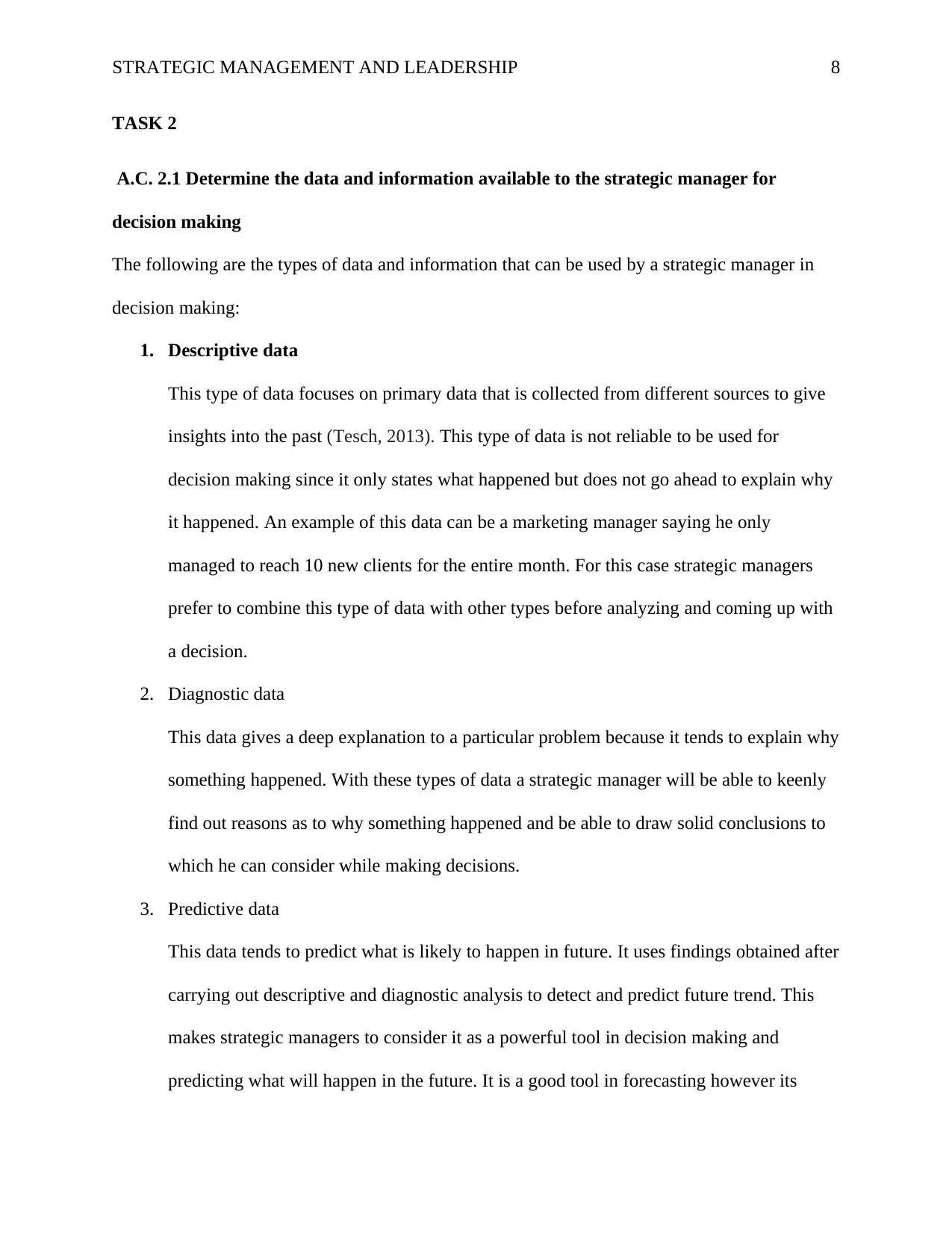
STRATEGIC MANAGEMENT AND LEADERSHIP 8
TASK 2
A.C. 2.1 Determine the data and information available to the strategic manager for
decision making
The following are the types of data and information that can be used by a strategic manager in
decision making:
1. Descriptive data
This type of data focuses on primary data that is collected from different sources to give
insights into the past (Tesch, 2013). This type of data is not reliable to be used for
decision making since it only states what happened but does not go ahead to explain why
it happened. An example of this data can be a marketing manager saying he only
managed to reach 10 new clients for the entire month. For this case strategic managers
prefer to combine this type of data with other types before analyzing and coming up with
a decision.
2. Diagnostic data
This data gives a deep explanation to a particular problem because it tends to explain why
something happened. With these types of data a strategic manager will be able to keenly
find out reasons as to why something happened and be able to draw solid conclusions to
which he can consider while making decisions.
3. Predictive data
This data tends to predict what is likely to happen in future. It uses findings obtained after
carrying out descriptive and diagnostic analysis to detect and predict future trend. This
makes strategic managers to consider it as a powerful tool in decision making and
predicting what will happen in the future. It is a good tool in forecasting however its
TASK 2
A.C. 2.1 Determine the data and information available to the strategic manager for
decision making
The following are the types of data and information that can be used by a strategic manager in
decision making:
1. Descriptive data
This type of data focuses on primary data that is collected from different sources to give
insights into the past (Tesch, 2013). This type of data is not reliable to be used for
decision making since it only states what happened but does not go ahead to explain why
it happened. An example of this data can be a marketing manager saying he only
managed to reach 10 new clients for the entire month. For this case strategic managers
prefer to combine this type of data with other types before analyzing and coming up with
a decision.
2. Diagnostic data
This data gives a deep explanation to a particular problem because it tends to explain why
something happened. With these types of data a strategic manager will be able to keenly
find out reasons as to why something happened and be able to draw solid conclusions to
which he can consider while making decisions.
3. Predictive data
This data tends to predict what is likely to happen in future. It uses findings obtained after
carrying out descriptive and diagnostic analysis to detect and predict future trend. This
makes strategic managers to consider it as a powerful tool in decision making and
predicting what will happen in the future. It is a good tool in forecasting however its
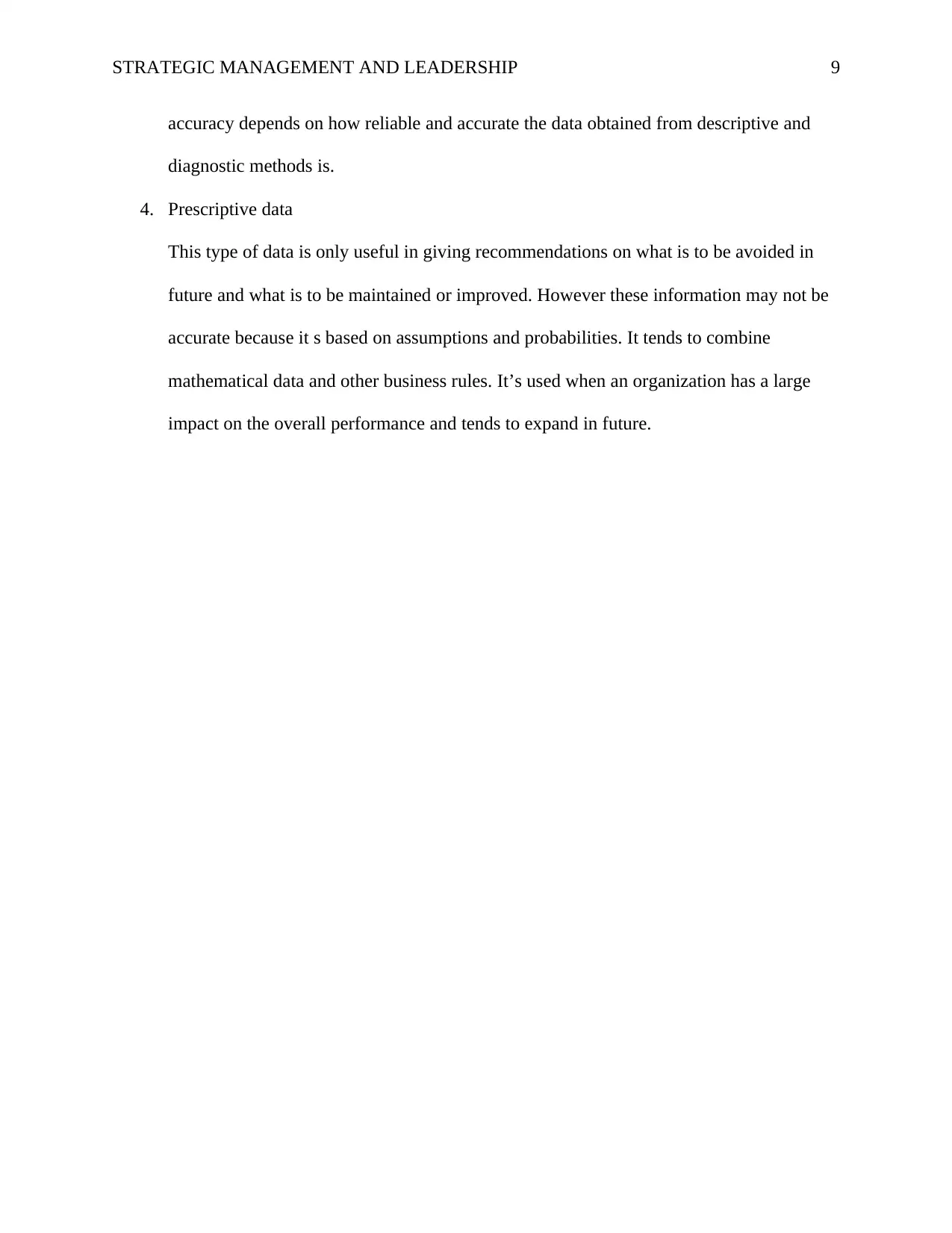
STRATEGIC MANAGEMENT AND LEADERSHIP 9
accuracy depends on how reliable and accurate the data obtained from descriptive and
diagnostic methods is.
4. Prescriptive data
This type of data is only useful in giving recommendations on what is to be avoided in
future and what is to be maintained or improved. However these information may not be
accurate because it s based on assumptions and probabilities. It tends to combine
mathematical data and other business rules. It’s used when an organization has a large
impact on the overall performance and tends to expand in future.
accuracy depends on how reliable and accurate the data obtained from descriptive and
diagnostic methods is.
4. Prescriptive data
This type of data is only useful in giving recommendations on what is to be avoided in
future and what is to be maintained or improved. However these information may not be
accurate because it s based on assumptions and probabilities. It tends to combine
mathematical data and other business rules. It’s used when an organization has a large
impact on the overall performance and tends to expand in future.
⊘ This is a preview!⊘
Do you want full access?
Subscribe today to unlock all pages.

Trusted by 1+ million students worldwide
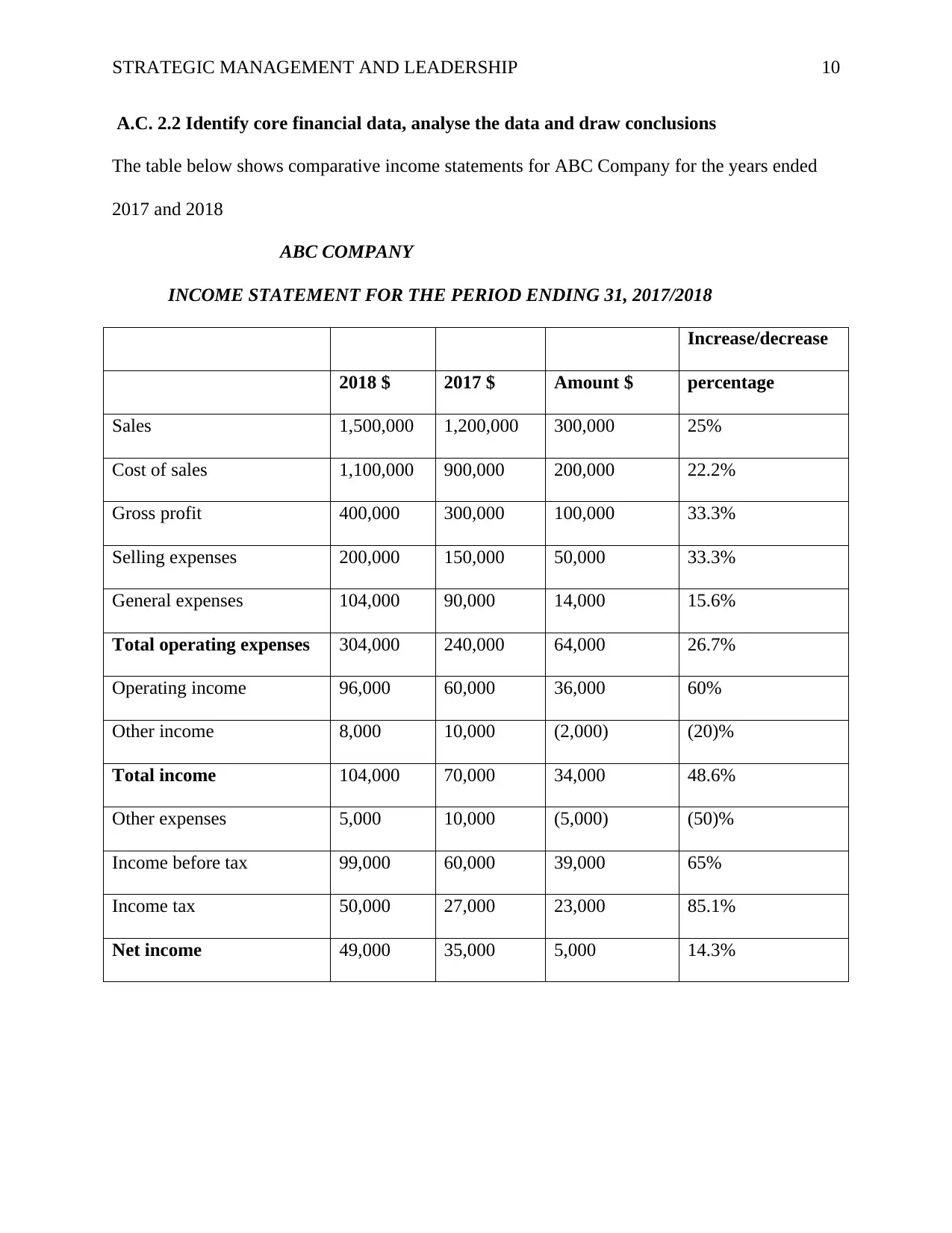
STRATEGIC MANAGEMENT AND LEADERSHIP 10
A.C. 2.2 Identify core financial data, analyse the data and draw conclusions
The table below shows comparative income statements for ABC Company for the years ended
2017 and 2018
ABC COMPANY
INCOME STATEMENT FOR THE PERIOD ENDING 31, 2017/2018
Increase/decrease
2018 $ 2017 $ Amount $ percentage
Sales 1,500,000 1,200,000 300,000 25%
Cost of sales 1,100,000 900,000 200,000 22.2%
Gross profit 400,000 300,000 100,000 33.3%
Selling expenses 200,000 150,000 50,000 33.3%
General expenses 104,000 90,000 14,000 15.6%
Total operating expenses 304,000 240,000 64,000 26.7%
Operating income 96,000 60,000 36,000 60%
Other income 8,000 10,000 (2,000) (20)%
Total income 104,000 70,000 34,000 48.6%
Other expenses 5,000 10,000 (5,000) (50)%
Income before tax 99,000 60,000 39,000 65%
Income tax 50,000 27,000 23,000 85.1%
Net income 49,000 35,000 5,000 14.3%
A.C. 2.2 Identify core financial data, analyse the data and draw conclusions
The table below shows comparative income statements for ABC Company for the years ended
2017 and 2018
ABC COMPANY
INCOME STATEMENT FOR THE PERIOD ENDING 31, 2017/2018
Increase/decrease
2018 $ 2017 $ Amount $ percentage
Sales 1,500,000 1,200,000 300,000 25%
Cost of sales 1,100,000 900,000 200,000 22.2%
Gross profit 400,000 300,000 100,000 33.3%
Selling expenses 200,000 150,000 50,000 33.3%
General expenses 104,000 90,000 14,000 15.6%
Total operating expenses 304,000 240,000 64,000 26.7%
Operating income 96,000 60,000 36,000 60%
Other income 8,000 10,000 (2,000) (20)%
Total income 104,000 70,000 34,000 48.6%
Other expenses 5,000 10,000 (5,000) (50)%
Income before tax 99,000 60,000 39,000 65%
Income tax 50,000 27,000 23,000 85.1%
Net income 49,000 35,000 5,000 14.3%
Paraphrase This Document
Need a fresh take? Get an instant paraphrase of this document with our AI Paraphraser
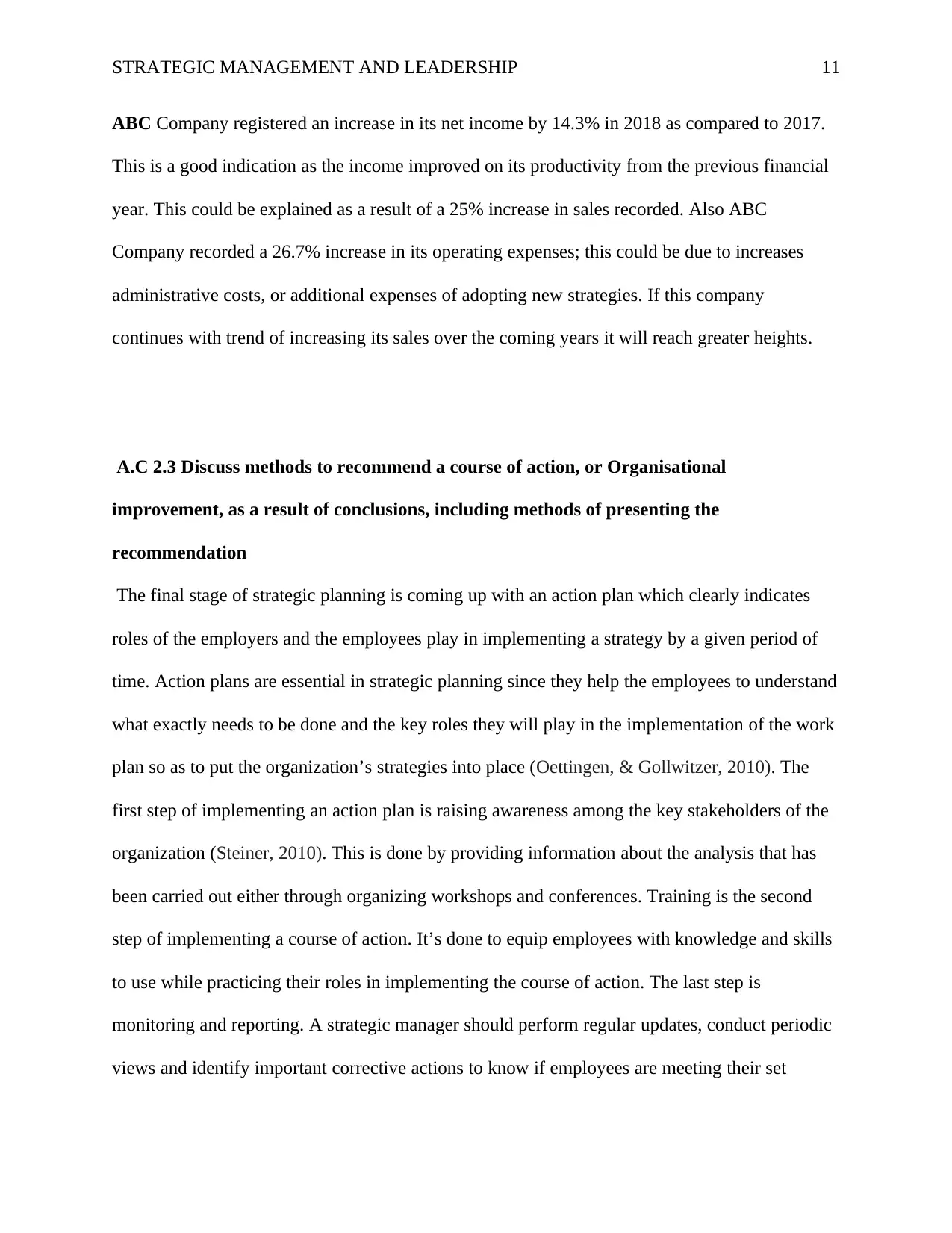
STRATEGIC MANAGEMENT AND LEADERSHIP 11
ABC Company registered an increase in its net income by 14.3% in 2018 as compared to 2017.
This is a good indication as the income improved on its productivity from the previous financial
year. This could be explained as a result of a 25% increase in sales recorded. Also ABC
Company recorded a 26.7% increase in its operating expenses; this could be due to increases
administrative costs, or additional expenses of adopting new strategies. If this company
continues with trend of increasing its sales over the coming years it will reach greater heights.
A.C 2.3 Discuss methods to recommend a course of action, or Organisational
improvement, as a result of conclusions, including methods of presenting the
recommendation
The final stage of strategic planning is coming up with an action plan which clearly indicates
roles of the employers and the employees play in implementing a strategy by a given period of
time. Action plans are essential in strategic planning since they help the employees to understand
what exactly needs to be done and the key roles they will play in the implementation of the work
plan so as to put the organization’s strategies into place (Oettingen, & Gollwitzer, 2010). The
first step of implementing an action plan is raising awareness among the key stakeholders of the
organization (Steiner, 2010). This is done by providing information about the analysis that has
been carried out either through organizing workshops and conferences. Training is the second
step of implementing a course of action. It’s done to equip employees with knowledge and skills
to use while practicing their roles in implementing the course of action. The last step is
monitoring and reporting. A strategic manager should perform regular updates, conduct periodic
views and identify important corrective actions to know if employees are meeting their set
ABC Company registered an increase in its net income by 14.3% in 2018 as compared to 2017.
This is a good indication as the income improved on its productivity from the previous financial
year. This could be explained as a result of a 25% increase in sales recorded. Also ABC
Company recorded a 26.7% increase in its operating expenses; this could be due to increases
administrative costs, or additional expenses of adopting new strategies. If this company
continues with trend of increasing its sales over the coming years it will reach greater heights.
A.C 2.3 Discuss methods to recommend a course of action, or Organisational
improvement, as a result of conclusions, including methods of presenting the
recommendation
The final stage of strategic planning is coming up with an action plan which clearly indicates
roles of the employers and the employees play in implementing a strategy by a given period of
time. Action plans are essential in strategic planning since they help the employees to understand
what exactly needs to be done and the key roles they will play in the implementation of the work
plan so as to put the organization’s strategies into place (Oettingen, & Gollwitzer, 2010). The
first step of implementing an action plan is raising awareness among the key stakeholders of the
organization (Steiner, 2010). This is done by providing information about the analysis that has
been carried out either through organizing workshops and conferences. Training is the second
step of implementing a course of action. It’s done to equip employees with knowledge and skills
to use while practicing their roles in implementing the course of action. The last step is
monitoring and reporting. A strategic manager should perform regular updates, conduct periodic
views and identify important corrective actions to know if employees are meeting their set
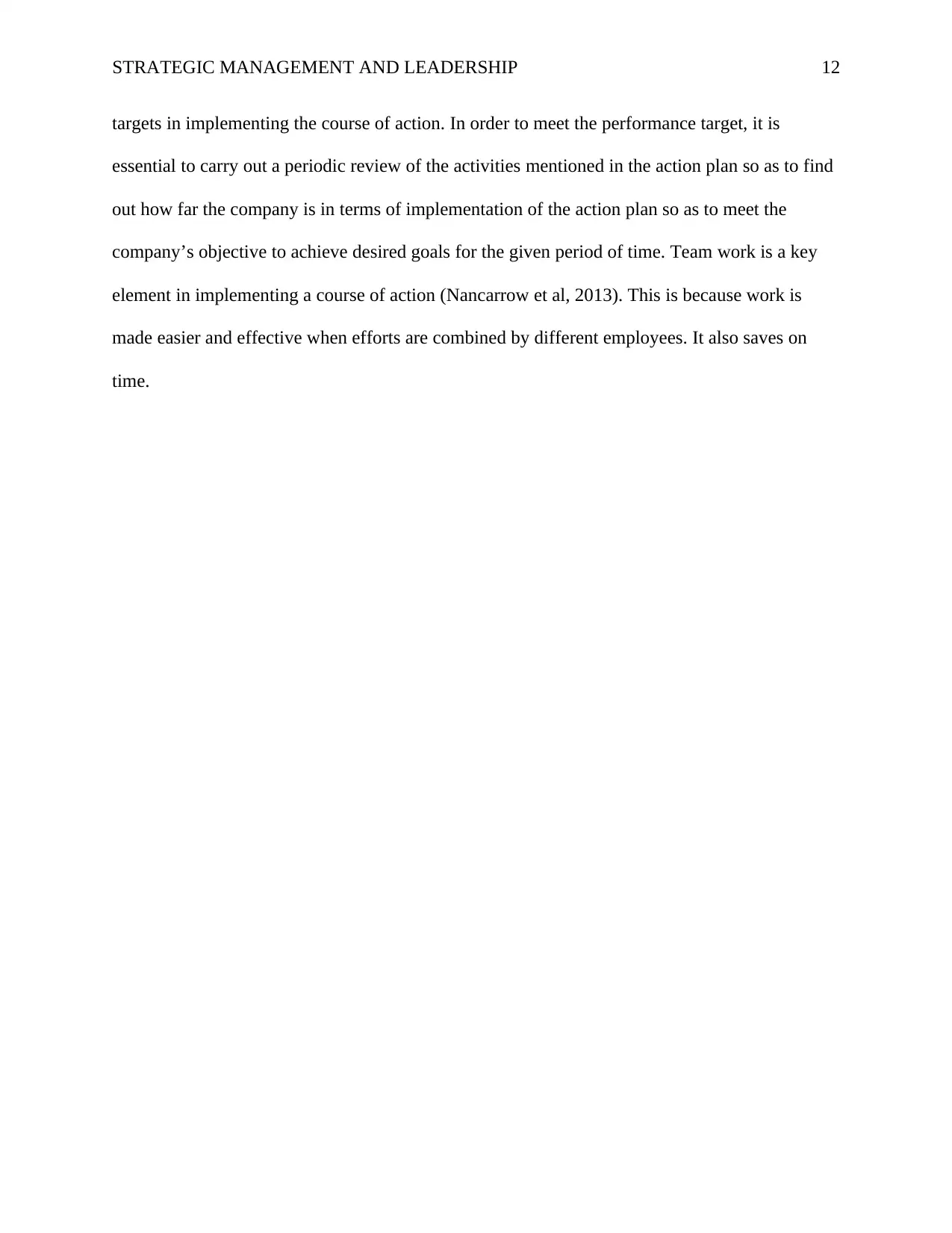
STRATEGIC MANAGEMENT AND LEADERSHIP 12
targets in implementing the course of action. In order to meet the performance target, it is
essential to carry out a periodic review of the activities mentioned in the action plan so as to find
out how far the company is in terms of implementation of the action plan so as to meet the
company’s objective to achieve desired goals for the given period of time. Team work is a key
element in implementing a course of action (Nancarrow et al, 2013). This is because work is
made easier and effective when efforts are combined by different employees. It also saves on
time.
targets in implementing the course of action. In order to meet the performance target, it is
essential to carry out a periodic review of the activities mentioned in the action plan so as to find
out how far the company is in terms of implementation of the action plan so as to meet the
company’s objective to achieve desired goals for the given period of time. Team work is a key
element in implementing a course of action (Nancarrow et al, 2013). This is because work is
made easier and effective when efforts are combined by different employees. It also saves on
time.
⊘ This is a preview!⊘
Do you want full access?
Subscribe today to unlock all pages.

Trusted by 1+ million students worldwide
1 out of 22
Related Documents
Your All-in-One AI-Powered Toolkit for Academic Success.
+13062052269
info@desklib.com
Available 24*7 on WhatsApp / Email
![[object Object]](/_next/static/media/star-bottom.7253800d.svg)
Unlock your academic potential
Copyright © 2020–2025 A2Z Services. All Rights Reserved. Developed and managed by ZUCOL.




